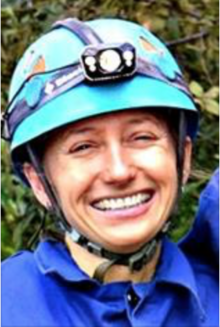Becca Peixotto
Becca Peixotto | |
|---|---|
 | |
| Nationality | American |
| Education |
|
| Known for | Discovery of Homo naledi[2] |
| Scientific career | |
| Fields | Anthropology Archaeology |
| Institutions | American University |
| Thesis | Against the Map: Resistance Landscapes of the Great Dismal Swamp |
| Doctoral advisor | Dr. Daniel O. Sayers |
Rebecca (Becca) Peixotto is an American archaeologist who is best known for her contribution to the Rising Star Expedition as one of the six Underground Astronauts, a group of scientists tasked with excavating the Rising Star Cave System.[3] She has also participated in the Great Dismal Swamp Landscape Study and is an experienced wilderness educator.[4]
Education
Peixotto received her Ph.D. in Anthropology, Archaeology Specialization, in 2017 from American University with her dissertation Against the Map: Resistance Landscapes of the Great Dismal Swamp.[5] Peixotto obtained a B.A. in Slavic Area Studies and Mathematics from the University of Alabama in Huntsville.[1] She pursued further studies abroad at the University of Amsterdam, obtaining an M.A. in Discourse and Argumentation Studies.[citation needed] She returned to the U.S. to attend the American University in Washington, DC, where she earned a M.A. in Public Anthropology, Archaeology Specialization, in 2013.[citation needed]
Rising Star Expedition
In October 2013, Peixotto and five others were chosen to be part of a specialized excavation team for the Rising Star Expedition.[6] The purpose of the 21-day expedition, sponsored by The National Geographic Society and the University of the Witwatersrand, Johannesburg, was to excavate fossils which had been recently found in a deep cave complex in the Rising Star Cave System, near Johannesburg, South Africa.[7]
The critical skills and physical attributes sought for the excavation team by lead scientist and University of the Witwatersrand professor Lee Berger were a "master's degree or higher in palaeontology, archeology or an associated field; caving experience; and the ability to fit through an 18-centimeter (about 7-inch) space."[8] The six women scientists were crucial in the successful "excavation of arguably one of the most important fossil finds in human history – a new species referred to as Homo naledi."[9]
Peixotto, Hannah Morris, Marina Elliott, Alia Gurtov, K. Lindsay Eaves, and Elen Feuerriegel, along with a team of sixty international scientists, excavated "one of the richest collections of hominin fossils ever discovered—some 1,550 fossil fragments, belonging to at least 15 individual skeletons."[6]
Since this expedition, Peixotto has continued to work with a team to learn more about Homo naledi.[10] As of 2021, this team has discovered two dozen naledi individuals and evidence that suggests this cave system might have served as burial grounds for Homo naledi.[10]
Publications (selected)
- 2021. Montgomery, A, and Peixotto, B. Explore Paleoanthropology Fieldwork: A Virtual Expedition to Rising Star Cave (South Africa) with DinalediVR. American Biology Teacher, in press.
- 2021. Peixotto, B, Klehm, C, Eifling, K. Rethinking Field Sites as Wilderness Activity Sites. Advances in Archaeological Practice special issue Health and Wellness in Archaeology: Improving Wellness and Response, in press.
- 2020. Peixotto, B, Elliot MC. Meet Neo: Your Ancient Cousin. Frontiers for Young Minds 7:155. doi: 10.3389/frym.2019.00155.[11]
Awards and honors (selected)
- #IfThenSheCan Statue, 2022[12]
- 2020 AAAS/IF THEN Ambassador Outreach Grant[13]
- 2016 The Explorer’s Club Washington Group Exploration and Field Research Grant[14]
- 2016 WINGS WorldQuest Flag Carrier Award[15]
Early life
As a child, Peixotto enjoyed searching her grandparents’ old Vermont farmhouse for artifacts.[16][17] She initially studied engineering at college, but according to Peixotto, "When I took my first archaeology course, it was like a lightbulb turned on! I could combine all my experiences and interests in science, the outdoors, teaching, and history, to learn more about our collective human past."[16]
Peixotto was a Girl Scout.[17]
See also
References
- ^ a b "Faculty Profile Rebecca Peixotto". American University Washington D.C. Retrieved 31 March 2022.
- ^ Weisser, Ryan (30 September 2015). "Meet the Local Student Who Helped Discover a New Species". Washingtononian. Retrieved 31 March 2022.
- ^ Feltman, Rachel. "Meet the six female 'underground astronauts' who recovered our newest relative". Washington Post. Retrieved 31 March 2022.
- ^ "Who are the Underground Astronauts". EWN. Retrieved 31 March 2022.
- ^ Peixotto, R. A. (2017). Against the Map: Resistance Landscapes in the Great Dismal Swamp (thesis). American University. doi:10.17606/4a1s-1312.
- ^ a b Yong, Ed (10 September 2015). "6 Tiny Cavers, 15 Odd Skeletons, and 1 Amazing New Species of Ancient Human". The Atlantic. Retrieved 31 March 2022.
- ^ Shreeve, James (10 September 2015). "This Face Changes the Human Story. But How?". National Geographic. Archived from the original on September 10, 2015. Retrieved 31 March 2022.
- ^ "Ali Gurtov '07 Is One of The Rising Star Expedition's "Underground Astronauts"". Wellesley College. Retrieved 31 March 2022.
- ^ Mathy, MH (13 October 2015). "Shining Light of Discovery". The Clarion. Retrieved 31 March 2022.
- ^ a b Woodward, Aylin. "A child's skull found deep inside a South African cave offers new clues about a group of mysterious human ancestors". Business Insider. Retrieved 2022-04-09.
- ^ Peixotto, Becca; Elliott, Marina C. (2020). "Meet Neo: Your Distant Cousin?". Frontiers for Young Minds. 7. doi:10.3389/frym.2019.00155.
- ^ "Smithsonian puts focus on STEM standouts for Women's History Month". Washington Post. ISSN 0190-8286. Retrieved 2022-04-01.
- ^ "IF/THEN Ambassadors reflect on their first year". Association of Science and Technology Centers. 2020-09-10. Retrieved 2022-03-31.
- ^ ECWG_Admin (11 January 2017). "2016 Exploration and Field Research Grant Recipients – Explorers Club Washington Group". Retrieved 2022-03-31.
- ^ "Flag Carriers". WINGS WorldQuest. Retrieved 2022-03-31.
- ^ a b "Dr. Becca Peixotto: Digging Deep". Museum of Life and Science. 2021-10-01. Retrieved 2022-03-31.
- ^ a b "| IF/THEN® Collection". www.ifthencollection.org. Retrieved 2022-03-31.
